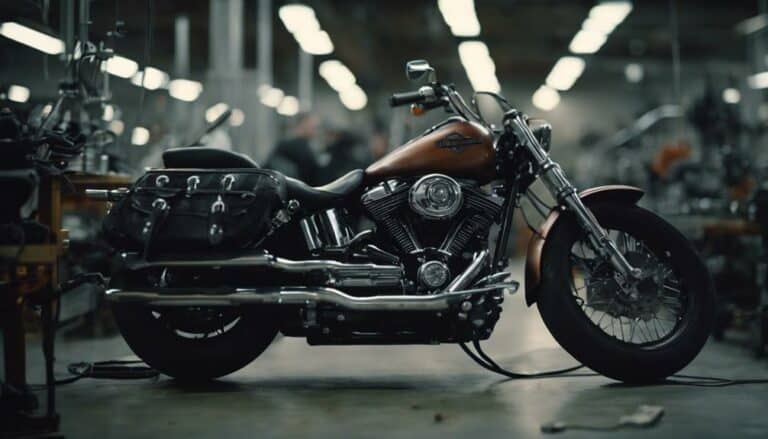Picture this: the rumble of a Harley Davidson as it cruises down the open road, evoking a sense of freedom and adventure.
But have you ever wondered what percentage of this iconic motorcycle's production actually takes place overseas? The answer may surprise you.
Harley Davidson's approach to international manufacturing holds key insights into its global strategy and market positioning.
Explore the intricacies of their production distribution and the implications it carries for the brand's future.
Key Takeaways
- Harley-Davidson shifted European market manufacturing overseas.
- Assembly plants in India, Brazil, and Thailand facilitate global production.
- Strategy to counter EU tariffs and maintain competitiveness.
- Adapting to global trade dynamics with overseas production advancements.
Harley-Davidson's Overseas Production Overview
Harley-Davidson's overseas production strategy involves shifting motorcycle manufacturing for the European market to assembly plants located outside the U.S. This move is primarily in response to the tariffs imposed by the EU, prompting Harley-Davidson to rethink its production locations.
The company has already established assembly plants in India and Brazil for international production. Furthermore, Harley-Davidson is set to inaugurate a motorcycle assembly plant in Thailand this year. The Thailand plant will focus on assembling bikes using components manufactured in the U.S., showcasing a blend of international production and domestic sourcing.
The shift towards international assembly plants is a strategic decision by Harley-Davidson to navigate the complexities of global trade dynamics efficiently. While this transition is anticipated to take between nine to 18 months to complete, it underscores the company's adaptability in response to market demands and regulatory challenges, positioning Harley-Davidson for continued success in the international motorcycle market.
Historical Background on Harley-Davidson Ownership
During its early years of operation, the ownership structure of Harley-Davidson underwent several significant transformations, shaping the company's trajectory in the motorcycle industry.
As Harley-Davidson evolved, its historical background revealed a strategic shift towards international expansion. The company not only established assembly plants but also began moving a significant portion of its production overseas to countries like India, Brazil, and Thailand. This shift to international facilities was crucial in balancing Harley-Davidson's global manufacturing operations to cater to diverse market demands effectively.
Founding History of Harley-Davidson
Founded in the early 20th century, the establishment of Harley-Davidson marked a significant milestone in the history of motorcycle manufacturing. Over the years, Harley-Davidson hasn't only solidified its presence in the U.S. but has also expanded its operations globally.
The company's venture into international production began with the opening of its first overseas assembly plant in Brazil in 1999. This move was followed by the inauguration of a plant in India in 2011, where the production of Street-model motorcycles for select European markets takes place.
In 2018, Harley-Davidson further diversified its manufacturing locations by announcing plans to open a motorcycle assembly plant in Thailand. These overseas production facilities play a crucial role in mitigating the impact of tariffs on U.S. manufacturing, showcasing Harley-Davidson's strategic approach to maintaining a competitive edge in the motorcycle industry while honoring its rich founding history.
Impact of Overseas Production on Harley-Davidson
With the increasing impact of EU tariffs on its financials, Harley-Davidson is strategically shifting production of motorcycles for the European market overseas. Europe stands as the second-largest revenue market for Harley-Davidson, following the U.S., with nearly 40,000 motorcycles sold in the European Union by the company in 2017. As Harley-Davidson aims to boost international sales to approximately 50% of total sales, the move to shift production overseas is a calculated production strategy to counterbalance the financial impact of EU tariffs. This shift in production location not only reflects Harley-Davidson's commitment to the EU market but also signifies a proactive approach to adapt to the changing trade dynamics.
- Harley-Davidson's European market is crucial, representing significant revenue.
- Over 40,000 motorcycles were sold by Harley-Davidson in the EU in 2017.
- Shifting production overseas is part of Harley-Davidson's strategy to reach 50% international sales.
- The move aims to counteract the financial implications of EU tariffs on Harley-Davidson's operations.
Future Prospects for Harley-Davidson's Production Strategy
Harley-Davidson's future production strategy is strategically oriented towards expanding overseas facilities to navigate the challenges posed by EU tariffs and maintain competitiveness in the European market. By shifting production for EU-bound motorcycles overseas, Harley-Davidson aims to mitigate the impact of EU tariffs while keeping U.S. production focused on domestic sales. This approach allows the company to balance its U.S. and international production, effectively addressing tariff challenges.
The decision to expand overseas production is crucial for sustaining Harley-Davidson's business in Europe amidst regulatory obstacles. It demonstrates Harley-Davidson's commitment to competitiveness in the European market and alleviating the financial strain caused by EU tariffs. Through this strategic shift, Harley-Davidson is proactively adapting to the evolving international trade landscape, ensuring a strong foothold in the European market while optimizing its production capabilities to meet market demands efficiently.
Conclusion
In conclusion, Harley Davidson's overseas production accounts for a relatively small percentage of its overall production. Despite facing challenges such as trade tensions and tariffs, the company remains committed to maintaining a strong focus on U.S.-based manufacturing.
Looking ahead, one may wonder: Will Harley-Davidson's decision to shift production for the European market overseas impact its long-standing tradition of domestic manufacturing?

